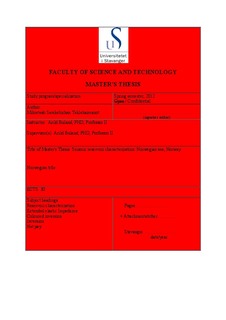| dc.contributor.author | Teklehaimanot, Mihreteab Serekebirhan | |
| dc.date.accessioned | 2014-02-06T09:53:08Z | |
| dc.date.issued | 2012 | |
| dc.identifier.citation | | no_NO |
| dc.identifier.uri | http://hdl.handle.net/11250/183654 | |
| dc.description | Master's thesis in Petroleum Geosciences engineering | no_NO |
| dc.description.abstract | A three step work flow seismic reservoir characterization method, comprised of the extended elastic impedance, coloured inversion and net pay estimation was tested in a data obtained from the western part of the deep water Vøring basin in the Norwegians sea.
By integrating the information from the well and performing direct hydrocarbon indicator analysis, the zone of interest was defined. Extended elastic impedance analysis was performed to determine the optimal angles corresponding to fluid and lithology projection. The optimal angles chosen from the well logs do not necessarily represent the optimal angles in the seismic, but give a good insight of the properties of interest and fine tuning is required. Scaled reflectivities at the respective χ angles were produced. The fluid and lithology cubes were produced χ =200 and χ =-500 respectively.
A coloured inversion operator was designed from the wells available. The operator re-shapes the amplitude spectra of the seismic to the well and hence earth’s amplitude spectrum within the band limits of the spectrum In addition to the amplitude re-shaping a -90 phase rotation was applied as part of the inversion algorithm. The scaled reflectivities were convolved with the coloured inversion operator, resulting in band limited impedances.
Seismic net pay estimation was performed on the band limited impedance of the fluid projection with the assumption that the average band limited impedance within the zone of estimation is proportional to the net if the tuning effect is removed. A simple wedge model is used in obtaining a detuning function to eliminate the tuning effect, boosting the average band limited impedance in the thicker parts. Seismic calibration aimed at associating the average band limited impedance with the seismic net-to-gross was also applied. Due to the lack of adequate well data, well calibration was not performed. The algorithm can be used to estimate net-pay for reservoir thicknesses above the tuning thickness depending on the lower frequency component in the seismic data.
The work flow has been found useful and can be particularly important in areas where there is limited data. | no_NO |
| dc.language.iso | eng | no_NO |
| dc.publisher | University of Stavanger, Norway | no_NO |
| dc.relation.ispartofseries | Masteroppgave/UIS-TN-IPT/2012; | |
| dc.subject | petroleumsteknologi | no_NO |
| dc.subject | petroleumsgeologi | no_NO |
| dc.title | Seismic Reservoir Characterization: Norwegian Sea, Norway | no_NO |
| dc.type | Master thesis | no_NO |
| dc.subject.nsi | VDP::Technology: 500::Rock and petroleum disciplines: 510::Petroleum engineering: 512 | no_NO |
| dc.description.embargo | 2017-07-01 | |
